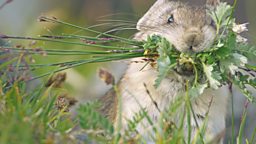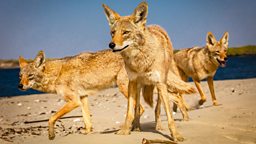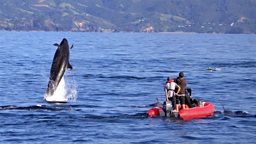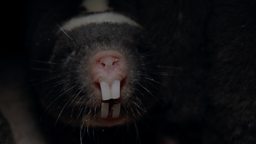Madagascar: the land of mysterious mammals
By Mammals Researcher, Jess Webster

To capture the story of one of the forest’s most unusual inhabitants, the 91热爆 team ventured into the remote jungles of eastern Madagascar, a large island lying 250 miles off the coast of mainland Africa. Having broken away from the rest of the continent some 165 million years ago, Madagascar is famed for its rich biodiversity and host of cast away creatures. Evolving in isolation from the rest of the world, the plants and animals found here are among the most unique on earth, with 90% of species appearing nowhere else. For locals and tourists alike, it is an extraordinary place where over a hundred species of lemur can be found leaping through the trees, while iconic baobabs tower over the land, known locally as ‘mother of the forest.’

For the mammals team, our mission was to document one of the country’s lesser-known residents - the elusive lowland streaked tenrec. Native to tropical lowland forests, these small mammals can be distinguished by their bold yellow stripes and spend most of their lives roving through the thick forest undergrowth. To overcome the daunting task of simply finding our filming subjects in this entangled world, we enlisted the help of a local Malagasy research and conservation group. Their knowledge of the surrounding forest and native wildlife was instrumental to the operation and with time and perseverance, they helped us locate a small family of tenrecs nestled amongst the leaf litter.
Found only on Madagascar, lowland streaked tenrecs belong to a group of more than 30 known species of tenrec, all exhibiting a diverse array of characteristics and behaviour. How their early ancestors reached the island of Madagascar from the mainland remains something of a mystery, but a leading theory is that their descendants rafted across the channel on floating pieces of vegetation, ultimately diversifying into the variety of species we see today. This means that despite their hedgehog like appearance, the lowland streaked tenrec is most closely related to its much larger neighbours on mainland Africa, including aardvarks and more surprisingly, elephants. Yet their striking resemblance to shrews and other spiny mammals is not merely a coincidence, instead representing a clear example of convergent evolution. In this intriguing scenario, mammals in different parts of the world have developed similar morphological traits by adapting to the same niche.

Working daily with our local guides we were able to film the story of a tenrec mother and her young as they navigated their dangerous forest habitat during the wet season, a testament to their incredible adaptations and strong family bonds. Spending most of their time sifting through the leaf litter to unearth juicy worms and other nutritious invertebrates, foraging excursions were broken up with time spent hiding from the outside world in carefully constructed burrows underground. A small tenrec out in the open is an easy target for many lurking forest predators including snakes, fossa’s and mongoose.

Perhaps for this very reason and like many mammals, the first stages of tenrec life are spent in tight knit family groups with high levels of parental care. This family dynamic enabled us to observe and film our most remarkable behaviour of all- ‘stridulation.’ Through a special organ found in no other mammal, we excitedly watched our mother tenrec as she rubbed her quills together rapidly to create an ultrasonic vibration that, while inaudible to humans, is detectable to other tenrecs.
For the crew It was an amazing sight to witness the tenrecs coming back together as a family after becoming separated on a foraging trip and to observe this rare form of communication in action- an ingenious strategy for staying connected in the dense forest. As we watched our mother tenrec safeguard her young, and having learned that these little tenrecs reach sexual maturity around a month after birth, it was strange to think these young babies could soon become parents of their own.
Despite their notable charm and fascinating behaviour, there have been very few studies on the lowland streaked tenrec and there is still much to learn about its ecology. Like all tenrecs and so many other species of mammal across Madagascar, what is apparent is their vulnerability to habitat loss and to a rapidly changing world. As in many countries, Madagascar’s forests are in rapid decline, with approximately 200,000 hectares being lost to deforestation each year. In total, it is thought that Madagascar has now lost a staggering 80% of its natural areas.
it was a humbling experience to spend time with an animal so few have ever seen
Despite this sad statistic, as part of the field crew it was a humbling experience to spend time with an animal so few have ever seen and to be able revisit this special mammalian group for the series, which appeared in the original Life of Mammals more than 20 years ago. As we left our tenrec family in this spectacular pocket of Madagascan forest, it felt like we had all gained a greater appreciation of the incredible characters that make up this extraordinary class of animal, and a renewed sense of the need to protect not only mammals, but all of the amazing life on our planet.




























